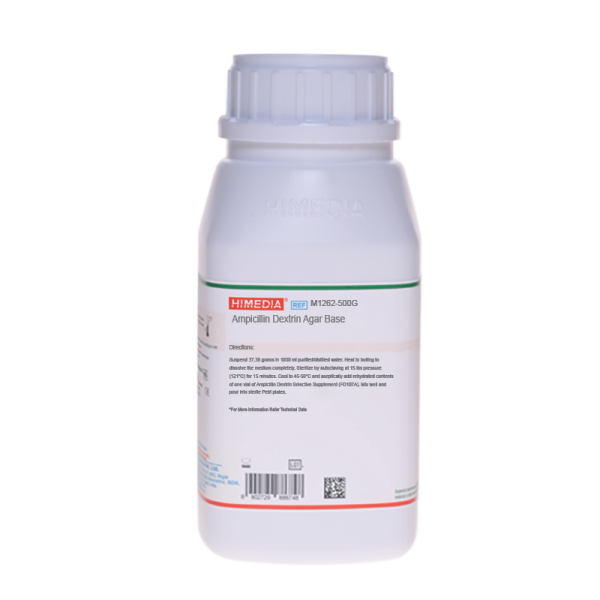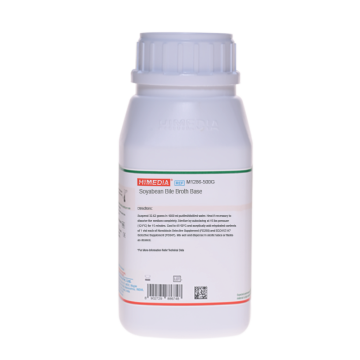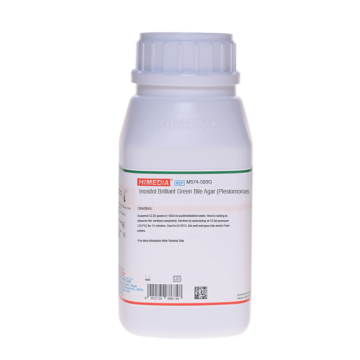 Your enquiry has been submitted
Your enquiry has been submitted
Ampicillin Dextrin Agar Base
Aeromonas species#CC293D
Intended Use:
Recommended for differential and selective isolation of Aeromonas species from water samples using membrane filter technique.
Composition**
| Ingredients | g/L |
|---|---|
| Tryptose | 5.000 |
| Dextrin | 10.000 |
| Yeast extract | 2.000 |
| Sodium chloride | 3.000 |
| Potassium chloride | 2.000 |
| Magnesium sulphate | 0.200 |
| Iron (III) chloride | 0.100 |
| Bromothymol blue | 0.080 |
| Agar | 15.000 |
Final pH (at 25°C): 8.0±0.1
**Formula adjusted, standardized to suit performance parameters
Directions
Suspend 37.38 grams in 1000 ml purified / distilled water. Heat to boiling to dissolve the medium completely. Sterilize by autoclaving at 15 lbs pressure (121°C) for 15 minutes. Cool to 45-50°C and aseptically add rehydrated contents of one vial of AD Selective Supplement (FD107A). Mix well and pour into sterile Petri plates.
Principle And Interpretation
Aeromonas is a genus of bacteria that is ubiquitous in the environment. It is present in all types of water worldwide, as well as in food and soil. There are approximately 16 different species in this genus, the best known of which is Aeromonas hydrophila. Physiologically, Aeromonas are similar to bacteria in the coliform group and can be isolated from similar environments. Aeromonas are commonly isolated from a variety of aquatic environments, including freshwater, estuarine, brackish, and salt waters. Some members of this group of bacteria have been implicated in human disease, although not all strains appear to be pathogenic to humans (1). Aeromonas species can cause various enteric symptoms in children and adults (2,3). Ampicillin Dextrin Agar Base is used for isolation and differentiation of Aeromonas species from other gram-negative rods such as Pseudomonas and Enterobacteriaceae from water samples by membrane filter technique (4). Tryptose and yeast extract provide nitrogenous compounds along with other essential nutrients for growth of Aeromonas. Sodium chloride maintains the osmotic balance of the medium. Aeromonas forms acid from dextrin, which is indicated by colour change from blue to yellow by the pH indicator, bromothymol blue. The selectivity of the medium is increased by the addition of Ampicillin. The effectiveness of Ampicillin as selective agent has been reported by several workers (5,6,7). After 24 hours of growth on this agar, colonies are sprayed with Nadi reagent (1% solution of N,N,N,N'-tetramethyl-p-phenylene-diammonium dichloride). A positive Nadi reaction (dextrin degradation) is indicated by a purple colour at the periphery of the colony. Dextrin fermentation is also indicated by yellow colonies. Aeromonas species appear as 1-1.5 mm bright yellow colonies. Vancomycin may be added to inhibit Bacillus species (8).
Type of specimen
Water samples
Specimen Collection and Handling:
For water samples, follow appropriate techniques for sample collection, processing as per guidelines & local standards (8).
Highly polluted water samples : Dilutions of the water sample are prepared and 0.1 ml is directly plated on the medium.
Drinking water : 1,10 and 100 ml water sample is filtered and the membrane is placed on the medium.
Plates are incubated at 35°C for 18-24 hours. Appearance of bright yellow coloured colonies indicate presence of Aeromonas.
After use, contaminated materials must be sterilized by autoclaving before discarding.
Warning and Precautions
Read the label before opening the container. Wear protective gloves/protective clothing/eye protection/ face protection. Follow good microbiological lab practices while handling specimens and culture. Standard precautions as per established guidelines shall be followed while handling specimens. Safety guidelines may be referred in individual safety data sheets.
Limitations :
- Further biochemical and serological tests must be carried out for complete identification (8).
Performance and Evaluation
Performance of the medium is expected when used as per the direction on the label within the expiry period when stored at recommended temperature.
Quality Control
Appearance Light yellow to greenish yellow homogeneous free flowing powder
Gelling Firm, comparable with 1.5% Agar gel
Colour and Clarity of prepared medium Dark green coloured clear to slightly opalescent gel forms in Petri plates
Reaction Reaction of 3.74% w/v aqueous solution at 25°C. pH : 8.0±0.1
pH 7.90-8.10
Cultural Response Cultural characteristics observed with added AD Selective Supplement (FD107A), after an incubation at 35-37°C for 18-24 hours.
| Organism | Inoculum (CFU) | Growth | Recovery | Colour of colony |
|---|---|---|---|---|
| Aeromonas hydrophila ATCC 7966 (00063*) | 50-100 | luxuriant | >=50% | bright yellow |
| Escherichia coli ATCC 25922 (00013*) | 50-100 | none-poor | <=10% | - |
| Staphylococcus aureus subsp. aureus ATCC 25923 (00034*) | >=104 | inhibited | 0% | - |
Key: (*) Corresponding WDCM numbers.
Storage and Shelf Life
Store between 10-30°C in a tightly closed container and the prepared medium at 2-8°C. Use before expiry date on the label. On opening, product should be properly stored dry, after tightly capping the bottle in order to prevent lump formation due to the hygroscopic nature of the product. Improper storage of the product may lead to lump formation. Store in dry ventilated area protected from extremes of temperature and sources of ignition. Seal the container tightly after use. Product performance is best if used within stated expiry period.
Disposal
User must ensure safe disposal by autoclaving and/or incineration of used or unusable preparations of this product. Follow established laboratory procedures in disposing of infectious materials and material that comes into contact with sample must be decontaminated and disposed of in accordance with current laboratory techniques (9,10).
Reference
- Embrey M. A., Parkin R. T., and Balbus J. M., (Ed.), 2002, Handbook of CCL Microbes in Drinking Water, American Water Works Association: Denver, CO.
- Atkinson M., 1986, Culture, Vol. 7, No. 2.
- Moyer N. P., 1987, J. Clin. Microbiol., 25, 2044-2048.
- Havelaar A. H., During M. and Versteigh J. F. M., 1987, J. Appl. Bacteriol., 62 (3):279-87.
- Moulsdale M. T. 1983, The Lancet, 1:351.
- Richardson C. J., Robinson J. O., Wagener L. B., Burke V. J., 1982, Antimicrob., Chemother., 9:267.
- Rogol M., Sechlter I., Grenber L., Gerichter Ch. B., 1979, J. Med. Microbiol., 12:229.
- Lipps WC, Braun-Howland EB, Baxter TE, eds. Standard methods for the Examination of Water and Wastewater, 24th ed. Washington DC:APHA Press; 2023.
- Isenberg, H.D. Clinical Microbiology Procedures Handbook 2nd Edition.
- Jorgensen, J.H., Pfaller, M.A., Carroll, K.C., Funke, G., Landry, M.L., Richter, S.S and Warnock., D.W.(2015) Manual of Clinical Microbiology, 11th Edition. Vol. 1.
| Product Name | Ampicillin Dextrin Agar Base |
|---|---|
| SKU | M1262 |
| Product Type | Regular |
| Physical Form | Powder |
| Origin | Animal |
| Packaging type | HDPE |
| References | 1. Embrey M. A., Parkin R. T., and Balbus J. M., (Ed.), 2002, Handbook of CCL Microbes in Drinking Water, American WaterWorks Association: Denver, CO. |
| Customized Product Available | No |









